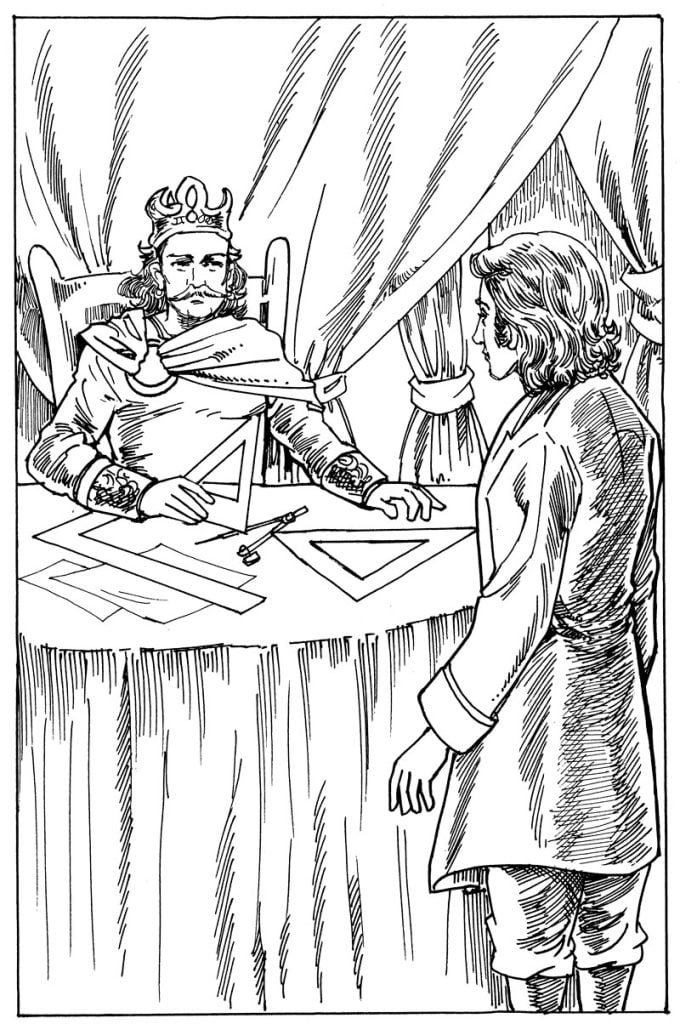Chapter-2
Soon, I was surrounded with a crowd of people and noticed that they all were quite odd. Each person’s head was tilted to one side or the other, with one eye turned inward and the other looking up. Their clothes were adorned with the images of celestial bodies and musical instruments. Some of the people I believed were servants, and each of them carried a ‘flapper’ made of a stick with a pouch tied to the end. Their job was to aid conversation by striking the ear of the listener and the mouth of the speaker at the appropriate times to prevent their masters’ minds from wandering off.

I was taken to the king who was sitting behind a table loaded with mathematical instruments. We had to wait for an hour before getting an opportunity to arouse the king from his thoughts. Then the king was struck with the flapper. The king spoke something, and my ear was struck with the flapper as well. I could not speak any of the languages that the king spoke. Then I was taken to an apartment and served dinner.
A teacher was sent to teach me the language of the island. I was able to learn several sentences. I learnt that the name of the island was Laputa, which in their language meant ‘floating island’. A tailor was also sent to provide me with new clothes. While I was waiting for these clothes, the king ordered the island to be moved. It was taken to a point above the capital-city of the kingdom, Lagado. As the island move, it passed through several villages. On the way, it collected petitions from the king’s subjects by means of ropes sent down to the lands below. The language of the Laputans relied heavily on mathematical and musical concepts. They valued these theoretical disciplines above everything.
The Laputans hated practical geometry, thinking it vulgar—so much so that they made sure that there were no right angles in their buildings. They were very good with charts and figures but very clumsy in practical matters. They practiced astrology and read changes in the celestial bodies.
I wished to see this amazing island. I requested the king to grant me permission to visit the island. The king granted permission graciously and also ordered my tutor to attend me. Basically, I wanted to know how that island moved. Here is a brief account of the island for my readers.
The flying or floating island was exactly circular, its diameter 7837 yards or about four miles and a half consequently it contained ten thousand acres. At the centre of the island, there was a gap about fifty yards in diameter, from where the astronomers descended into a large dome, called Flandona Gagnole or the astronomer’s cave which was situated at the depth of a hundred yards beneath the upper surface of the adamantine.
In that cave, there were twenty lamps which continually burned and cast a strong light into every part of the cave. The place was occupied with a great variety of sextants, quadrants, telescopes, astrolabes and other astronomical instruments. But the greatest curiosity, upon which the fate of the island depended, was a loadstone of an extraordinary size and shape. This loadstone resembled a weaver’s shuttle. It was six yards in length and the thickest part was at least three yards over. This magnet was sustained by an immovable and a very strong axle which passed though its middle, upon which it played, and was balanced so accurately that the weakest hand could turn it. It was moved round with a resolute hollow cylinder which was four yards in diameter, placed horizontally, and supported by eight adamantine feet, each six yards high. In the middle of the concave side, there was a groove twelve inches deep, in which the extremities of the axle were lodged.
The magnet moved the island with its magnetic force, since it had two charges that could be reversed by means of an attached control. The mineral that acted upon the magnet was large enough to allow it to move only over the country directly beneath it. When the king wanted to punish a particular region of the country, he kept the island above it, depriving the lands below of the sun and rain. Anyhow, such measures failed to work in one town, because the rebellious inhabitants had already stored the provisions of food in advance. They planned to force the island to come so low that it would been trapped for ever and they could kill the king and his officials in order to take over the government. The king and his family were not allowed to leave the floating island.

